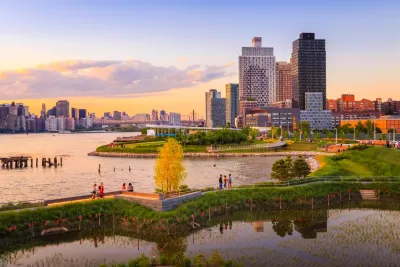Storm resilience is a key design element of Hunter’s Point South Park in New York.

Karim Doumar reports on Hunter’s Point South Park, an 11-acre park that has transformed what was once a waterfront industrial area in Long Island City, Queens. The park includes storm resilient design features, which Doumar says have already proven successful:
As phase one neared completion in 2012, Hurricane Sandy and its 4-foot storm surge inundated the entire thing. And then, calmly and with great precision, the water drained right back out into the river at a pace the sewer system could handle, leaving the park intact. Construction resumed just days later.
The second phase, which opened in June, has also been designed to withstand storm effects. “Instead of concrete walls and buttresses guarding the plot from the river, this park is the river’s friend. Twice a day, as the high tide rolls in, Hunters Point South Park becomes a marsh,” says Doumar. Future plans for the surrounding area include 5,000 units of housing for middle- and low-income residents.
For now, says Doumar, Hunter’s Point South Park is an example of how green infrastructure can be a successful buffer against the forces of nature while also providing recreational space. “Instead of concrete buttresses that once dominated the riverside, Hunters Point South Park’s relationship with the river is dominated by slow, rocky descents into the sea, and a tide that works with the landscape.”
FULL STORY: A Storm-Resilient Park in Queens

Alabama: Trump Terminates Settlements for Black Communities Harmed By Raw Sewage
Trump deemed the landmark civil rights agreement “illegal DEI and environmental justice policy.”

Planetizen Federal Action Tracker
A weekly monitor of how Trump’s orders and actions are impacting planners and planning in America.

The 120 Year Old Tiny Home Villages That Sheltered San Francisco’s Earthquake Refugees
More than a century ago, San Francisco mobilized to house thousands of residents displaced by the 1906 earthquake. Could their strategy offer a model for the present?

In Both Crashes and Crime, Public Transportation is Far Safer than Driving
Contrary to popular assumptions, public transportation has far lower crash and crime rates than automobile travel. For safer communities, improve and encourage transit travel.

Report: Zoning Reforms Should Complement Nashville’s Ambitious Transit Plan
Without reform, restrictive zoning codes will limit the impact of the city’s planned transit expansion and could exclude some of the residents who depend on transit the most.

Judge Orders Release of Frozen IRA, IIJA Funding
The decision is a victory for environmental groups who charged that freezing funds for critical infrastructure and disaster response programs caused “real and irreparable harm” to communities.
Urban Design for Planners 1: Software Tools
This six-course series explores essential urban design concepts using open source software and equips planners with the tools they need to participate fully in the urban design process.
Planning for Universal Design
Learn the tools for implementing Universal Design in planning regulations.
Clanton & Associates, Inc.
Jessamine County Fiscal Court
Institute for Housing and Urban Development Studies (IHS)
City of Grandview
Harvard GSD Executive Education
Toledo-Lucas County Plan Commissions
Salt Lake City
NYU Wagner Graduate School of Public Service


























